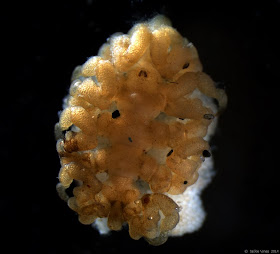When we found these tiny pink brittle stars in a Bull Kelp holdfast recently, Eric called them "fairies of the holdfast." Somehow it seemed like a perfect match.
I know it's hard to tell how small these animals are when there's nothing in the pictures for scale. The individuals I'm showing in these first few images were only 5-10 mm across from arm tip to arm tip.
The smallest brittle star was the palest:
The largest was the pinkest:
Brittle stars species can vary quite a bit in overall size. Some species are very small even as adults. So at first I wasn't sure if these were full-size animals or not.
When I looked under a microscope I noticed that there were lots of spines. In the picture below, that's a small section of the brownish central disc in the lower right corner covered with tiny spines. And that's one arm pointing to the upper left corner. Even the dorsal arm plates and the lateral arm spines projecting out to the sides are spiny! Although not a given, this made me suspicious that I was looking at juvenile brittle stars (rather than adults) as juvenile echinoderms are often very spiny.
While I was looking at these small brittle stars for identification clues, I was surprised to catch a glimpse of these at the tips of their arms:
Check out those hooks! Wow! I haven't looked at that many brittle stars under the microscope before, so I didn't know if these hooks were common.
We scanned a few books and I couldn't find a species description that mentioned these hooks until once again Philip Lambert (and William Austin) came to the rescue. In their book, Brittle Stars, Sea Urchins and Feather Stars of British Columbia, Southeast Alaska and Puget Sound (1997) they describe hooks like this for the Daisy Brittle Star (Ophiopholus kennerlyi).
Well, I am familiar with Daisy Brittle Stars as adults, but I hadn't identified juveniles before. But it so happens that we had also found an adult Daisy Brittle Star on the same day. I wondered if I could find the hooks on the adult.
The adult was very active...and the hooks were hard to see...but there they were! Look closely to see them in the photo above. They're adjacent and just to the left of each tubefoot. (Yes, the tubefeet are papillated in brittle stars.)
I had lots of questions after that...I was hooked! How do the brittle stars use these hooks? For grasping the substrate? Are they more important for juveniles than for adults? Are they an adaptation for wave-swept environments? Do the hooks play any role in capturing prey (as they do in basket stars)? Could the hooks be used in defense?
I posted about adult Daisy Brittle Stars last February, so you can review those pictures here. And if you'd like to see a closeup of the adult from this year, the following is an exceptional view of its central disc. And now we know that Daisy Brittle Stars start out pale pink and brown and gradually transition to having a highly patterned disc and arms!

















































